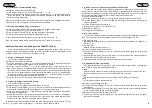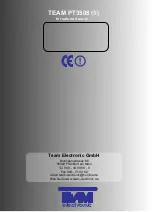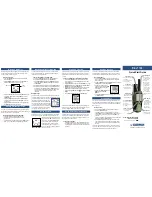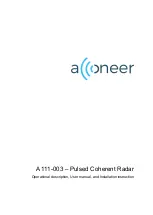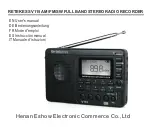
Operation of the PT-3508 (3) with the Basic Functions
1) Turning ON/OFF Your Radio
To turn on the PT-3508 (3), turn the rotary volume switch ( 3 ) clockwise until it clicks. A
sound signal can be heard through the speaker ( 14 ), the display ( 2 ) emits blue light and all
symbols appear. After the completion of this initial test, PT-3508 (3) is in receiving mode. The dis-
play reads
CH X
, where
X
represents the selected channel.
To shut off the handheld transceiver, turn the rotary volume switch ( 3 ) counterclockwise until
it clicks. All symbols in the display will disappear.
2) Set Up the Volume
To set the volume if no signal is received, push the monitor key [MONI] ( 7 ) to hear a noise
through the speaker. Now the volume can be adjusted. Turn the volume switch ( 3 ) clockwise to
increase the volume or counterclockwise to decrease it.
3) Channel Selection
PT-3508 ( 3 ) can store a maximum of 50 channels. By default, the PT-3508 (3) has 8 pro-
grammed PMR channels available. If you have a valid HAM license, you are permitted to pro-
gram additional channels with the software T-UP2.
To change a channel, turn the rotary channel selector switch ( 5 ). According to your indivi-
dual setup, the frequencies for transmission and reception will be displayed. The channel num-
bers increase in a clockwise direction and decrease in the counterclockwise direction.
Note:
If a channel position is not set, it will be skipped when turning the channel selector switch ( 5 ).
In that case, you will switch to a channel that is two or three steps away, although turning the
channel selector for just one step.
4) Transmission
Pushing the PTT key [PTT] ( 6 ) activates the transmitter.
Never transmit when the antenna ( 1 ) is detached.
According to the code of conduct, one should not transmit when incoming signals are recei-
ved. Only if no sound is audible through the speaker ( 14 ), and the LED ( 4 ) is off, the channel
is available.
If a muting function is activated for a channel, all incoming signals that are not encoded or
that use a different code will not be audible. Only the green light of the LED ( 4 ) indicates that a
station on the selected channel is transmitting. To hear the signal, push the monitor key [MONI] ( 7 ).
For two stations to communicate with each other, both must use the same channel. The
same applies to the muting functions. For further information refer to paragraph 2 of the chapter
“Muting Functions of the PT-3508 ( 3 )”.
If all requirements are met it can be transmitted. Keep the PTT key [PTT] ( 6 ) pushed as
long as you are talking. The LED ( 4 ) will emit red light and the rotary channel selector is disabled
during transmission. The Bar Indicator displays the signal strength. Keep the PT-3508 (3)
in an upright position at a distance of approximately 5 cm from your mouth, and talk loudly and
clearly. When finished talking, release the PTT key [PTT] ( 6 ). The unit will then switch back to
receiving mode.
5) Reception
Turned on, the PT-3508 ( 3 ) is always in receiving mode, unless it transmits.
PT-3508 ( 3 ) disposes of a noise suppression circuit ( squelch ). If there is no incoming signal
on the channel, a disturbing noise is audible through the speaker ( 14 ). To suppress this noise,
the squelch mutes the speaker until a signal is received. Then, the incoming signal disables the
squelch, and the signal passes through the speaker ( 14 ), while at the same time the LED ( 4 )
emits green light. The signal strength is indicated via the Bar Indicator .
ENGLISH
The squelch level can be adjusted, i.e. the minimum strength of an incoming signal to dis-
able the squelch can be set manually at the PT-3508 (3) or remotely via the software T-UP2.
Beside the squelch, there are other muting functions available. More information about these
features can be found in paragraph 2 of the chapter
Muting Functions of the PT-3508 ( 3 )
.
To hear weak signals on the selected channel, it is necessary to disable all muting functions
by pressing the monitor key [ MONI ] ( 7 ). In a normal setup, the squelch function is disabled
when pressing the monitor key [ MONI ] ( 7 ). In this case the LED ( 4 ) emits green light and the
symbol can be seen in the display. As long as the monitor key is pressed, a noise is audible.
Note:
The monitor key function can be altered with the software T-UP2. Please refer to paragraph
5 of the chapter
Muting Functions of the PT-3508 ( 3 )
.
6) Jack for External Ear- / Microphone
On the right side of the PT-3508 (3), two jacks Ø 2,5/3,5 mm [SPK]/[MIC] ( 13 ) are
located under a rubber cover. A combined ear- / microphone with PTT ( Push-To-Talk )
function or an other headset can be connected. As indicated on the rubber cover, the
upper jack is for the speaker and the lower jack for the microphone. The internal spea-
ker and microphone will be turned off when connecting a headset through those jacks.
To avoid damage on the connectors and the jacks through pulling forces, attach the
cable to the metal ring above the jacks via a cable fastener.
7) Charging the Rechargeable Battery Pack
Insert the DC connector of the adapter into the jack on the rear of the charger, before
connecting the adapter with a wall outlet ( 230 V / 50 Hz ). Now position the PT-3508 ( 3 ) with
the attached battery pack or just the battery pack by itself into the charging mould. The rechar-
geable battery pack is positioned correctly when the charging contacts show to the rear of the
charger.
The rechargeable battery pack needs to be charged before using it the first time.
The two-color LED on the charging mould indicates the charging status. If the LED emits red
light, charging is in process - CHARGING (RED). Once charging is completed, the charging cur-
rent is reduced, and the LED emits green light - (GRN) COMPLETE. It takes approximately 6
hours to fully charge the rechargeable battery pack. Once the LED starts emitting green light the
unit can be charged for another 2 hours maximum to use the entire capacity of the rechargeable
battery pack. Nevertheless, you should not exceed this time limit to not overcharge the rechar-
geable battery pack, which could reduce the capacity and shorten the life endurance of the
rechargeable battery pack. The charger always remains for 6 hours in the charging mode befo-
re reducing the charging current, regardless of the charging status of the accumulator. Therefo-
re, do not charge incompletely discharged battery packs since this also can cause overcharging.
Never try to charge alkaline batteries or other rechargeable battery packs than the one sup-
plied with the PT-3508 ( 3 ).
8) Low Power Alert Function
The PT-3508 ( 3 ) has a battery control function that prevents the complete discharge of the
rechargeable battery pack. When the charge level drops below a certain value in receiving mode
the PT-3508 (3) turns off automatically. To alert you about the low power status of the recharge-
able battery pack, the LED ( 4 ) blinks orange and a warning beep can be heard. In this low
power status, the transmitter is disabled.
The Low Power Alert function can be disabled with the software T-UP2.
The charge level can be checked at any time by pressing the PTT key. A bar indicator
at the bottom of the display shows the charge level of the rechargeable battery pack.
22
ENGLISH
23






